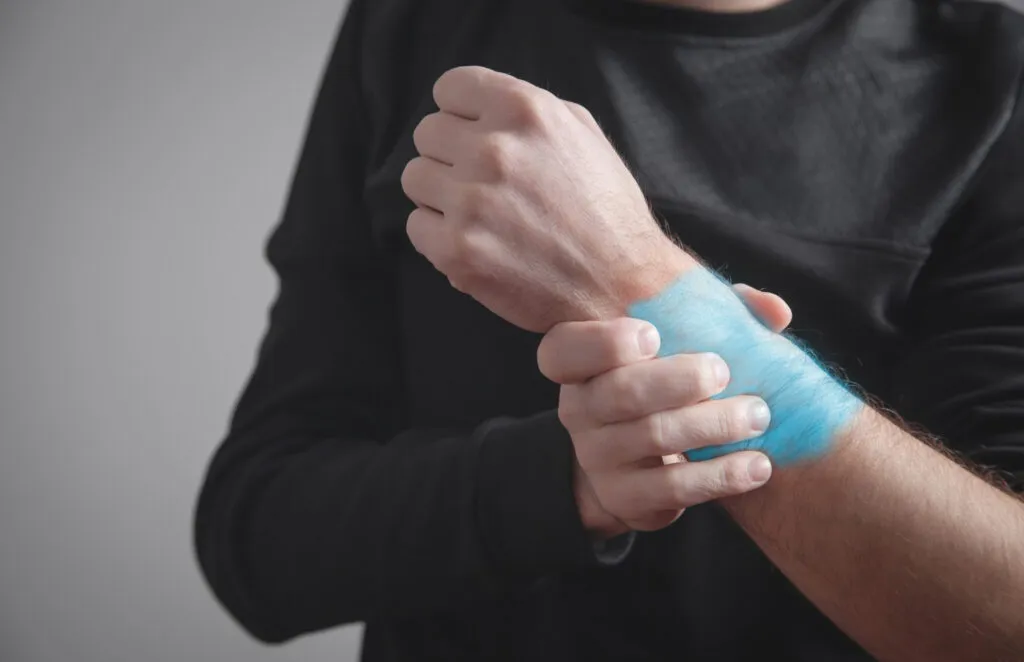Wrist & Hand Pain
What is Carpal Tunnel Syndrome?
The median nerve controls the movement of the hand and forearm muscles, allowing for flexion of the wrist and fingers. It also provides sensory information such as touch and pain to the palm and fingers, including the thumb, index, middle, and half of the ring finger, thereby enabling fine motor skills like gripping and thumb opposition.
Carpal tunnel syndrome is a common wrist and hand condition that may cause numbness, tingling, or weakness in the hand or wrist. This occurs due to pressure on the median nerve as it passes through the carpal tunnel space in the wrist. This condition typically develops from a combination of causes, such as an injury to the wrist or a medical condition that affects the nerves (like diabetes) or joints (like arthritis). Some people have a congenital narrowing of the carpal tunnel space making them more prone to carpal tunnel syndrome. Repeated wrist and hand movements, such as typing or using vibrating tools like a jackhammer, are also risk factors for carpal tunnel syndrome. The rigid structure of the carpal tunnel leaves very little wiggle room for the tendons and median nerve.
The carpal tunnel is a narrow and rigid space in the wrist composed of bones and ligaments. Nine tendons and the median nerve pass through the carpal tunnel into the hand, facilitating movement and sensation.
The tendons help you bend your fingers and thumbs, while the median nerve provides feeling in the palm-side of the thumb, index, middle, and ring finger, supporting muscle movement at the base of your thumb.

Do the symptoms of carpal tunnel syndrome come and go?
It’s not uncommon to only have carpal tunnel syndrome symptoms when you first wake up in the morning that go away with a few shakes of the wrist.
Over time, your symptoms may not improve as quickly or may occur during other activities, such as gripping the steering wheel in your car. You may also experience weakness in your grip, making it harder for you to turn the handle on the door or firmly grip a cup.
Getting an evaluation for carpal tunnel syndrome during the early stages may prevent your symptoms from getting worse.
What is ulnar neuropathy?
The ulnar nerve at the wrist controls the muscles of the hand, specifically the small muscles in the palm (hypothenar muscles) and the interossei muscles, allowing for fine motor movements like gripping and spreading the fingers, while also providing sensation to the little finger and half of the ring finger.
Ulnar neuropathy can be caused by repetitive stress from activities like typing or playing sports, falling onto an outstretched hand causing sprains or fractures, injuries to the triangular fibrocartilage complex (TFCC), ganglion cysts, direct trauma to the wrist, and overuse injuries from repetitive hand motions in certain occupations like carpentry or construction work. Injury to the nerve can cause pain, numbness, tingling at weakness.
What is De Quervain's tenosynovitis?
The abductor pollicis longus (APL) and extensor pollicis brevis (EPB) contribute to movement of the thumb. The APL moves the thumb away from the pinky finger on the palm while the EPB extends the thumb upwards.
This condition is often caused by repetitive motions of the thumb and wrist, or by a direct injury to the thumb. It can also be associated with pregnancy or rheumatoid arthritis.
The underlying cause for pain near the base of the thumb is irritation between the APL and EPB. The condition is most often diagnosed by the Finklestein test which involves extending the wrist towards the ground.
What is carpometacarpal joint arthritis?
The carpometacarpal (CMC) joint is where the base of the thumb metacarpal connects with wrist (carpal bone). CMC joint arthritis is a painful condition that occurs when the cartilage in the thumb’s CMC joint wears down. Some of the common conditions that cause CMC joint arthritis include aging, previous thumb injuries, repetitive hand movements that put stress on the thumb joint, being female, genetics, joint laxity (looseness), and inflammatory conditions like rheumatoid arthritis.
How is wrist and hand pain diagnosed?
The Bioinfinity Regenerative Medicine team has extensive experience diagnosing wrist and hand pain. We review your medical history, complete a physical exam, and discuss your symptoms. Imaging procedures such as an MRI, CT scan, or X-rays are often needed to allow your provider to see the bones and tissues inside your wrist and hand so they can identify the cause of your pain.

